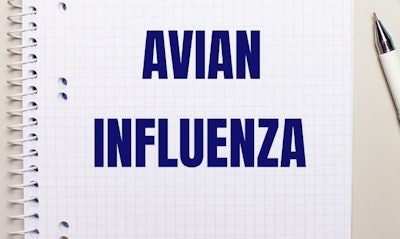
In a recent assessment of avian influenza in the 2021-2022 season, the European Food Safety Authority (EFSA) describes it as the worst ever such epidemic in Europe.
Among poultry, captive birds and wild species, HPAI virus was detected at around 5,300 locations in 36 countries. Of these, 2,398 outbreaks were in poultry, and affected 46 million birds.
While the report covers the period March-June 2022, EFSA says that the HPAI epidemic is still on-going.
Furthermore, persistence of the H5 virus — mainly the H5N1 serotype — indicates that the infection may have become endemic in wild birds, according to the agency. This means that the health risk from this HPAI virus family is now a year-round threat to European poultry, wildlife, and people.
Over the period March 16 to June 10, EFSA’s analysis indicates 1,182 detections of HPAI virus in 28 European countries. Of these, 750 were in poultry, 410 in wild birds, and 22 in captive birds.
According to EFSA’s analysis, 86% of the outbreaks in poultry were secondary infections. In other words, they involved farm-to-farm transmission.
Ahead of the next avian flu season in the fall/autumn, EFSA is calling for “suitable and sustainable” mitigations strategies to be put in place. Among these would be surveillance for early detection, and effective biosecurity measures. Looking further ahead, the agency proposes considering reducing poultry density in areas at high risk from HPAI.
Over the past season, there were very few confirmed influenza infections of avian origin among Europe’s human populations. However, EFSA highlights that investigations into cases in wild mammals such as foxes in Canada, the U.S. and Japan indicate the H5N1 serotype has genetic markers of adaption to replication in mammals.
Cases among European poultry drop again
As of July 3, 1,766 HPAI outbreaks have been recorded across Europe so far this year, based on the latest update of the Animal Disease Information System by the European Commission (EC). To date, one or more outbreaks have occurred in 20 European countries over this period.
For comparison, this season’s figure has just passed the total of 1,756 outbreaks registered with the EC by 24 European states throughout 2021.
However, this latest total for 2022 has increased by just two since the previous EC update on June 18. With a downward adjustment for Hungary, France’s total has increased by three to stand at 1,344.
According to French agriculture ministry, no new cases had been detected in the nation’s poultry flocks since May 17.
Three outbreaks officially registered with the World Organisation for Animal Health (WOAH) by France over the past two weeks were confirmed in mid-March. Cases occurred in a total of 54,000 birds — two flocks of ducks and one of chickens — in the Pays de la Loire regions in western France.
The EC notification system does not cover Russia or the United Kingdom (U.K.). Both countries have confirmed new outbreaks in poultry.
In the Ryazan and Kursk regions in Russia’s Central federal district, poultry in seven non-commercial poultry flocks have tested positive for the H5N1 HPAI virus since late May. Latest to be affected — two village flocks and one backyard — were in the second half of June. Each comprised between 41 and 250 birds.
Off the north coast of the U.K., H5N1 HPAI virus has been confirmed at a premises near Birsay in the Orkney Islands, according to the Scottish government. The usual control measures have been put in place, but no details are given on the number or type of birds involved in the outbreak. If it is confirmed to be in poultry, it will bring Scotland’s total outbreaks in the 2021-2022 season to 11, and that of the whole of the U.K. to 118.
In the first week of July, a further HPAI outbreak was confirmed at a small farm in The Netherlands. According to the agriculture ministry, affected were around 550 ornamental chickens and waterfowl at the premises in Watergang in North Holland. There are no poultry farms within 10 kilometers of the outbreak premises.
Widespread new cases among European wild birds
For the year to date, HPAI outbreaks in wild birds across Europe reported to the EC notification system have reached 2,122 (as of July 3). In total, 31 countries in the region have registered at least one outbreak in wild species through this system.
For comparison, 2,437 HPAI outbreaks in wild birds were registered with the EC’s system — also by 31 European states — during the whole of 2021.
Compared to the EC’s previous report on June 18, a further 220 outbreaks in wild species have been reported to the EC by 14 countries. Of these, 84 were in Germany, 35 in The Netherlands, 28 in Norway, and 16 in Denmark. There have also been further virus-positive cases in Iceland and Poland.
Also registering one or more new cases in wild birds with WOAH since June 27 have been Belgium, Faeroe Islands, Finland, France, Lithuania, Spain, Sweden, and the U.K.
Worthy of note is the wide variety of species affected in these recent HPAI outbreaks. Whereas the cases detected during the winter where mainly in wild ducks, geese and swans, seabirds have been most affected since the Northern hemisphere spring.
Despite the death of thousands of seabirds around the U.K. coast, their populations do not appear to be threatened with extinction. However, a Natural History Museum assessment suggests that the disease does add to the pressures on these vulnerable bird colonies around the country.
With few exceptions, the H5N1 HPAI virus was the serotype detected. However, seven wild birds in Norway tested positive for the H5N5 variant.
In Denmark, the disease situation involving the H5N8 virus serotype has been resolved, according to a recent notification to WOAH. Around the turn of the year, two birds had tested positive for this virus.
View our continuing coverage of the global avian influenza situation.
















